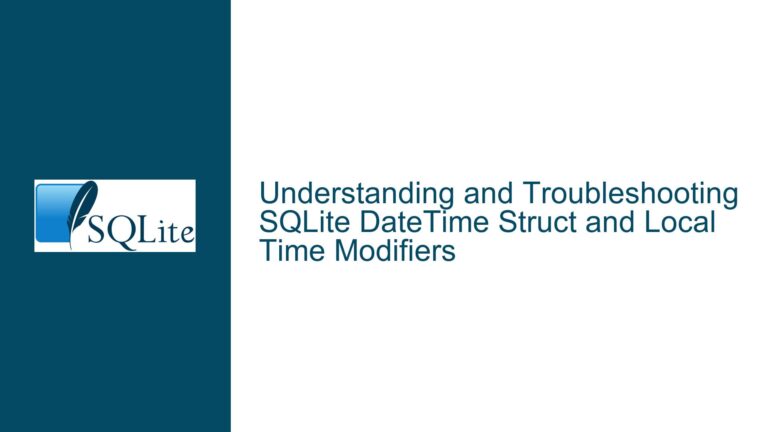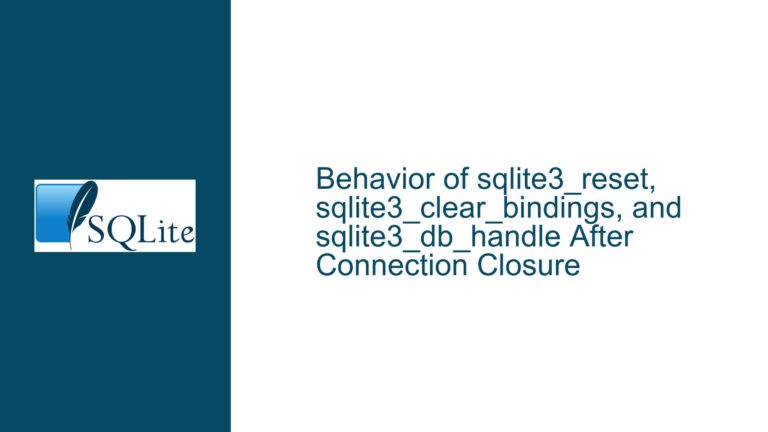Database Locking Issues in SQLite: Troubleshooting Guide
Understanding the "Database is Locked" Error
The "database is locked" error in SQLite is a common issue that developers encounter when working with concurrent database operations. This error occurs when one process attempts to access a database that another process is currently writing to or has not yet released. This can lead to frustrating delays and hinder application performance, especially in environments where multiple threads or processes are accessing the same database.
When a database connection is opened, SQLite uses a locking mechanism to manage access to the database file. The locking strategy is designed to ensure data integrity during write operations. However, if a process does not properly close its connections or finalize its statements, it can lead to situations where other processes are unable to access the database, resulting in the "database is locked" error.
Understanding the nuances of how SQLite manages locks and connections is crucial for diagnosing and resolving this issue. The error typically manifests during operations such as closing connections or executing queries, particularly when there are lingering open statements or unclosed transactions.
Investigating Potential Causes of Database Locking
Several factors can contribute to the "database is locked" error in SQLite. Identifying these potential causes is essential for implementing effective troubleshooting steps. Below are some common reasons why this error might occur:
Unfinalized Statements: One of the most frequent causes of the locking error is failing to finalize prepared statements after executing them. When using functions like
sqlite3_step(), developers must ensure that they callsqlite3_finalize()once they are done with the statement. If a statement remains active, it can prevent other processes from acquiring necessary locks.Long-Running Transactions: Transactions that take an extended period to complete can also lead to locking issues. If a transaction holds a write lock for too long, other processes trying to read or write will be blocked until the transaction completes. It’s essential to keep transactions as short as possible and commit changes promptly.
Improper Use of Connection Closing Functions: The choice between
sqlite3_close()andsqlite3_close_v2()can affect how connections are managed. Usingsqlite3_close()without ensuring that all statements have been finalized can leave lingering locks on the database file. Developers should be cautious about how they close connections and ensure that all resources are released before doing so.Concurrent Access by Multiple Processes: In scenarios where multiple processes attempt to access the database simultaneously, conflicts can arise if one process has not released its lock on the database file. This situation often occurs in multi-threaded applications where multiple threads may access the same database connection without proper synchronization.
Error Handling in Queries: If an error occurs during query execution, it’s vital to handle it correctly by finalizing or resetting statements as needed. Failing to do so can leave statements in an indeterminate state, causing locks to persist beyond their intended scope.
Database File Permissions: Sometimes, file system permissions can interfere with SQLite’s ability to lock and unlock files appropriately. Ensuring that the application has sufficient permissions to read from and write to the database file is crucial for preventing locking issues.
Using
sqlite3_exec()vssqlite3_step(): The method chosen for executing SQL commands can impact how locks are managed. Whilesqlite3_exec()handles statement finalization automatically, usingsqlite3_step()requires manual management of statement lifecycles, which can lead to errors if not handled correctly.Using
sqlite3_next_stmt(): When debugging locking issues, iterating through active statements associated with a connection usingsqlite3_next_stmt()can help identify any unfinalized statements that may be causing locks.
By understanding these potential causes, developers can better diagnose why they are encountering the "database is locked" error and take appropriate actions to resolve it.
Step-by-Step Troubleshooting and Solutions
When faced with a "database is locked" error in SQLite, there are several troubleshooting steps and solutions that developers can implement to resolve the issue effectively:
Check for Unfinalized Statements: Begin by reviewing your code for any instances where prepared statements may not have been finalized after execution. Use
sqlite3_stmt_busy()to check if any statements remain active when they should have been finalized. If you find such instances, ensure you callsqlite3_finalize()on those statements before closing any connections.Optimize Transaction Management: Evaluate your transaction management practices within your application code. Aim to keep transactions as short as possible by committing changes promptly after executing necessary operations. Avoid holding write locks longer than necessary, as this will reduce contention among concurrent processes.
Properly Close Connections: Ensure that you are using either
sqlite3_close()orsqlite3_close_v2()appropriately based on your application’s needs. Before closing a connection, confirm that all associated statements have been finalized and no transactions remain open.Implement Error Handling: Review your error handling logic within your SQL execution code. If an error occurs during query execution, make sure you handle it properly by finalizing or resetting any active statements associated with that query.
Use Debugging Tools: Utilize debugging tools available within SQLite, such as logging or tracing features, which can help identify which queries are causing delays or holding locks longer than expected.
Iterate Through Active Statements: If you suspect there are unfinalized statements but cannot locate them easily within your codebase, use
sqlite3_next_stmt()to iterate through all active statements associated with your connection. This method will provide you with pointers to those statements so you can inspect their status further.Review File Permissions: Check the file system permissions for your SQLite database file and ensure that your application has adequate permissions for reading and writing operations without restrictions.
Consider Connection Pooling: In multi-threaded applications, consider implementing connection pooling strategies that allow threads to share connections effectively while avoiding conflicts over database access.
Test with Simplified Queries: If you continue encountering locking issues despite following best practices, consider testing with simplified versions of your queries or reducing concurrency temporarily to isolate whether specific queries are contributing to the locking problem.
Consult Documentation and Community Resources: Finally, leverage official SQLite documentation and community forums for additional insights into specific scenarios similar to yours, as well as potential updates or patches related to locking behavior in newer versions of SQLite.
By systematically addressing these areas, developers can effectively troubleshoot and resolve "database is locked" errors in their SQLite applications, ensuring smooth operation and improved performance across their systems.






